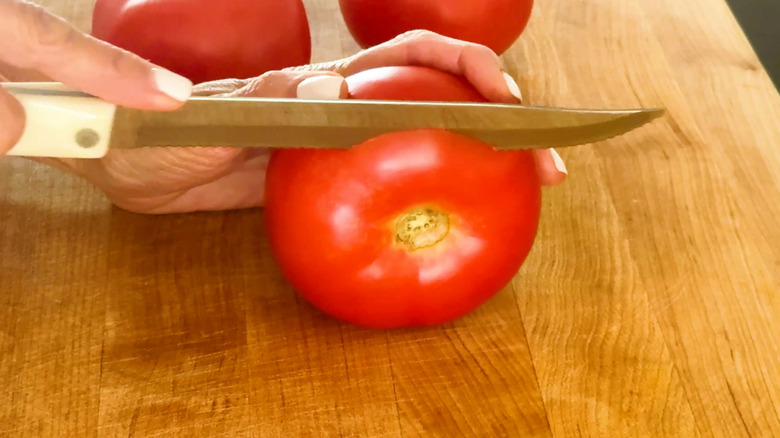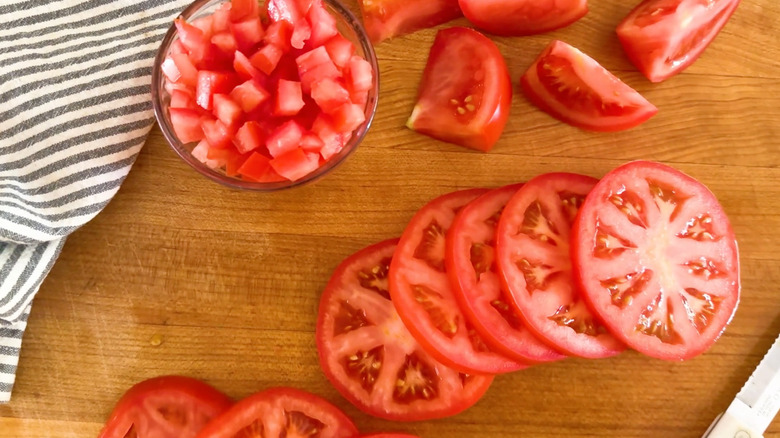How To Slice, Dice, And Wedge A Tomato - You're Doing It All Wrong
Tomatoes are a staple in most kitchens, but they can certainly present challenges to even experienced cooks. Creating perfect slices of tomato for your burgers, dicing them up for a flavor-packed bruschetta, or cutting them into wedges for a fresh garden salad might sound like simple preparations, but a few common mistakes can leave you with sloppy, uneven tomato chunks and a cutting board covered in watery pulp. To save you from disaster, Chowhound recipe developer Miriam Hahn reveals her tomato technique in this "You're Doing It All Wrong" video.
Hahn begins by emphasizing the importance of choosing the right tomatoes, as some types, particularly smaller varieties, aren't good choices for slicing and dicing. According to Hahn, "You want to choose tomatoes that are very firm," such as beefsteak tomatoes. Other common grocery store varieties to consider are plum tomatoes and globe tomatoes. The important thing is that the tomato is firm enough that it won't smush from the pressure of a knife. Speaking of which, it's time to address the first serious mistake most people make when cutting tomatoes.
When cutting tomatoes, use a serrated blade
"The No. 1 mistake people make when cutting tomatoes is using the wrong knife," says Hahn. "It is really important to use a sharp, serrated knife." The teeth of a serrated blade can easily break through the skin of the fruit, making for neat, even slices. It is imperative that the knife is sharp. If you're unsure whether your knife is due for a sharpening, check out our expert tips on how often to sharpen your knives. A sharp serrated blade should make quick work of a tomato. Just move the blade back and forth gently, and let the teeth do the hard part.
On the other hand, a dull, flat blade requires more pressure to penetrate the tomato's skin, and you risk crushing some of the fruit. Dull and flat blades can also slip, causing uneven slices, or worse, injury to the cook. "If you have a straight-edge blade that is very, very sharp, that will work too," Hahn says, "but my first choice is always using a serrated blade."
Slicing, dicing, and wedging: a technique for each
Sliced tomatoes are a must for good sandwiches and burgers, but people often make a mistake by cutting out the core of the tomato first. Hahn explains why this is actually a bad idea, as it will make slicing far more difficult going forward. "The core is what holds the whole tomato together, so you want to keep that intact." Instead, you should start by cutting off the top of the tomato to create a flat side. Align your knife parallel to the flat edge, and cut slices as thick as you'd like.
When it comes to diced tomatoes, many of us are making the same, soggy error. As Hahn explains, "A mistake that's often made when dicing is to leave the seeds and the pulp in the tomato, which can result in too much water." To avoid the mess, start by cutting off the top and bottom of the tomato and setting it flat on a cutting board. Slice it in half, then cut out the center of each half to remove the seeds and pulp. Slice what remains into thin strips, then cut across the strips to make small cubes.
Making tomato wedges starts the same way as slicing them, by cutting the top off. Place it cut-side up on a cutting board, and slice into as many wedges as you'd like. Hahn instructs us to "cut along that core, so everything stays intact." Avoid these simple mistakes, and you'll have a perfectly prepped tomato — it's as simple as that.

